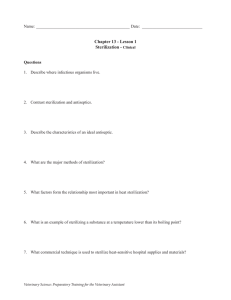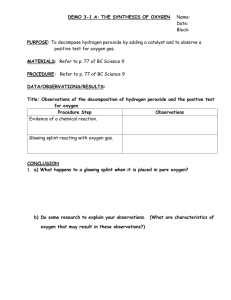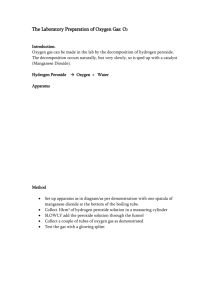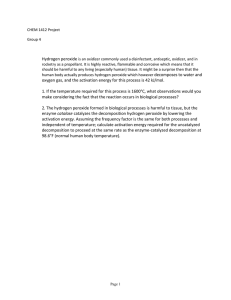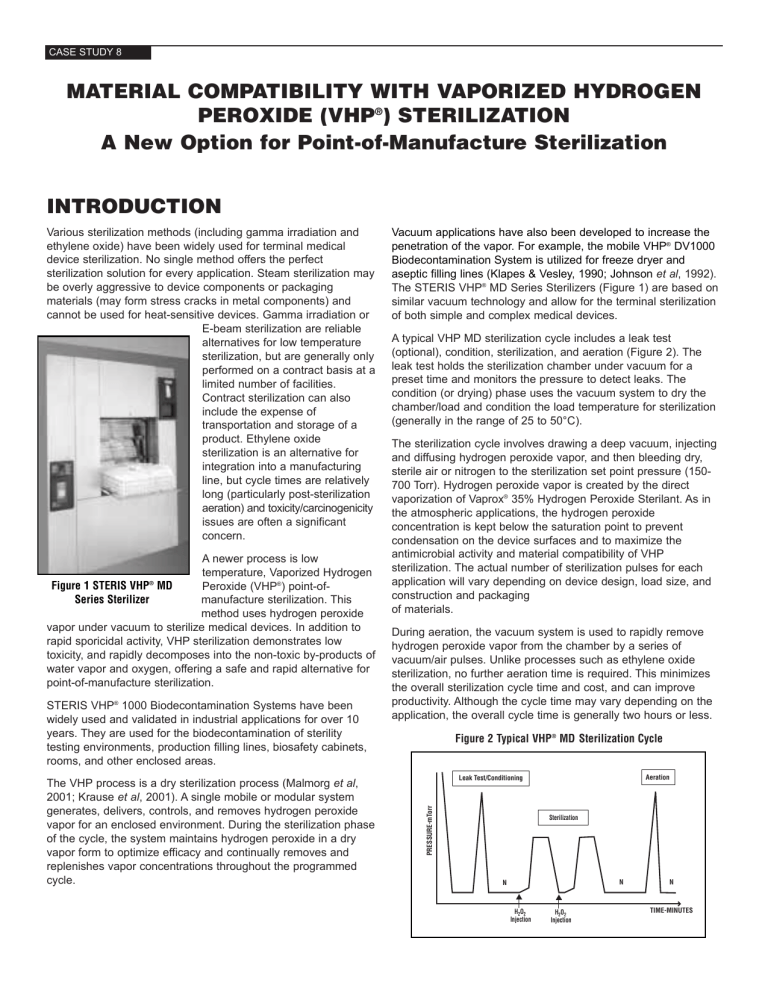
CASE STUDY 8
MATERIAL COMPATIBILITY WITH VAPORIZED HYDROGEN
PEROXIDE (VHP®) STERILIZATION
A New Option for Point-of-Manufacture Sterilization
INTRODUCTION
A newer process is low
temperature, Vaporized Hydrogen
Figure 1 STERIS VHP® MD
Peroxide (VHP®) point-ofSeries Sterilizer
manufacture sterilization. This
method uses hydrogen peroxide
vapor under vacuum to sterilize medical devices. In addition to
rapid sporicidal activity, VHP sterilization demonstrates low
toxicity, and rapidly decomposes into the non-toxic by-products of
water vapor and oxygen, offering a safe and rapid alternative for
point-of-manufacture sterilization.
STERIS VHP® 1000 Biodecontamination Systems have been
widely used and validated in industrial applications for over 10
years. They are used for the biodecontamination of sterility
testing environments, production filling lines, biosafety cabinets,
rooms, and other enclosed areas.
The VHP process is a dry sterilization process (Malmorg et al,
2001; Krause et al, 2001). A single mobile or modular system
generates, delivers, controls, and removes hydrogen peroxide
vapor for an enclosed environment. During the sterilization phase
of the cycle, the system maintains hydrogen peroxide in a dry
vapor form to optimize efficacy and continually removes and
replenishes vapor concentrations throughout the programmed
cycle.
Vacuum applications have also been developed to increase the
penetration of the vapor. For example, the mobile VHP® DV1000
Biodecontamination System is utilized for freeze dryer and
aseptic filling lines (Klapes & Vesley, 1990; Johnson et al, 1992).
The STERIS VHP® MD Series Sterilizers (Figure 1) are based on
similar vacuum technology and allow for the terminal sterilization
of both simple and complex medical devices.
A typical VHP MD sterilization cycle includes a leak test
(optional), condition, sterilization, and aeration (Figure 2). The
leak test holds the sterilization chamber under vacuum for a
preset time and monitors the pressure to detect leaks. The
condition (or drying) phase uses the vacuum system to dry the
chamber/load and condition the load temperature for sterilization
(generally in the range of 25 to 50°C).
The sterilization cycle involves drawing a deep vacuum, injecting
and diffusing hydrogen peroxide vapor, and then bleeding dry,
sterile air or nitrogen to the sterilization set point pressure (150700 Torr). Hydrogen peroxide vapor is created by the direct
vaporization of Vaprox® 35% Hydrogen Peroxide Sterilant. As in
the atmospheric applications, the hydrogen peroxide
concentration is kept below the saturation point to prevent
condensation on the device surfaces and to maximize the
antimicrobial activity and material compatibility of VHP
sterilization. The actual number of sterilization pulses for each
application will vary depending on device design, load size, and
construction and packaging
of materials.
During aeration, the vacuum system is used to rapidly remove
hydrogen peroxide vapor from the chamber by a series of
vacuum/air pulses. Unlike processes such as ethylene oxide
sterilization, no further aeration time is required. This minimizes
the overall sterilization cycle time and cost, and can improve
productivity. Although the cycle time may vary depending on the
application, the overall cycle time is generally two hours or less.
Figure 2 Typical VHP® MD Sterilization Cycle
Aeration
Leak Test/Conditioning
PRESSURE-mTorr
Various sterilization methods (including gamma irradiation and
ethylene oxide) have been widely used for terminal medical
device sterilization. No single method offers the perfect
sterilization solution for every application. Steam sterilization may
be overly aggressive to device components or packaging
materials (may form stress cracks in metal components) and
cannot be used for heat-sensitive devices. Gamma irradiation or
E-beam sterilization are reliable
alternatives for low temperature
sterilization, but are generally only
performed on a contract basis at a
limited number of facilities.
Contract sterilization can also
include the expense of
transportation and storage of a
product. Ethylene oxide
sterilization is an alternative for
integration into a manufacturing
line, but cycle times are relatively
long (particularly post-sterilization
aeration) and toxicity/carcinogenicity
issues are often a significant
concern.
Sterilization
N
N
H2O2
Injection
H2O2
Injection
N
TIME-MINUTES
CASE STUDY 8
Previous industrial experience has shown that hydrogen
peroxide vapor is compatible with, and safe for, a wide range of
materials typically used for medical devices, including metals
(300 series stainless steel, aluminum, and titanium), plastics
(polypropylene, polyethylene, and polycarbonate), and other
materials (silicones, glass, electronics etc.). In this report, a
detailed analysis of the material compatibility of the most widely
used medical device materials has been investigated using a
typical sterilization cycle.
MATERIALS AND METHODS
Medical device materials chosen for this study were based on a
representative sample of the materials used to manufacture
medical devices. A list of the materials follows (all materials were
obtained from McMaster Carr; Aurora, Ohio):
Elastomers:
1/32” white FDA Buna-N vinyl rubber 70A
1/8” thick black polyurethane 80A
1/8” thick EPDM rubber sheet 60A
Silicone rubber FDA Grade 1/16” thick
Rigid Plastics:
1/8” thick white nylon 6/6 Sheet
1/8” polypropylene sheet white translucent
1/8” thick high impact polystyrene sheet
1/8” thick ultra-high molecular weight polyethylene sheet
0.118” thick cast acrylic sheet
Sterilization Cycle. All materials were exposed to a single,
typical VHP MD sterilization cycle, developed at 30°C. All
exposures were conducted in a 5.00 cubic foot (0.14 cubic
meter) chamber. Following a successful leak test, two
conditioning pulses were performed to equilibrate the chamber
and its contents for temperature and humidity. This was
accomplished by evacuating the chamber to 2.3 mmHg, holding
the vacuum for 30 seconds, and then raising the pressure to
ambient by allowing warm, dry air to fill the chamber.
The sterilization phase consisted of evacuating the chamber to
1.0 mmHg and introducing 1.0 grams of 35% hydrogen peroxide
converted into vapor. The vapor introduction into the chamber
causes a slight pressure rise to ~ 10 mmHg. The initial vapor
concentration was 2.0 mg/l, which at the set temperature of 30°C
is equivalent to 80% saturation. The vapor was held at this
pressure for five minutes and then raised to 538 mmHg by
introducing warm, dry air into the chamber. Chamber contents
were exposed for an additional five minutes at this pressure,
then the chamber was evacuated by pulling the chamber
pressure back to 1 mmHg. This pulse sequence was repeated
for a total of 6 injection pulses. After the sterilization phase, 6
aeration pulses were used to aerate the chamber. Each of the
aeration pulses consisted of evacuating the chamber to 2.3
mmHg and holding for 30 seconds, followed by transitioning to
654 mmHg.
The total cycle time was 90 minutes, and a total weight of 6
grams of 35% hydrogen peroxide was used.
Material compatibility evaluation. All physical tests were
conducted at an ASTM certified testing facility. The material was
machined into test strips per the guidelines of ASTM D 638
(Standard Test Method for Tensile Properties of Plastics). All
exposed materials were compared to unexposed controls.
Elastomer materials were tested using the following methods:
ASTM D412 standard test methods for rubber and elastomers,
ASTM D2240 hardness determination, ASTM D638 tensile
properties, ASTM D2457 specular gloss, ASTM D6290 color
analysis. In addition, hydrogen peroxide residuals and FTIR
surface analyses were conducted. Rigid plastic materials were
tested using the following methods: ASTM D256 IZOD impact
resistance, ASTM D638 tensile properties, ASTM D2457
specular gloss, ASTM D6290 color analysis, hydrogen peroxide
residual analysis, and FTI surface analysis. FTIR analysis, using
diamond ATR correction, was performed using a Nicolet Impact
410 infrared spectrophotometer.
RESULTS AND DISCUSSION
Tensile Testing. Tensile testing measured the force required
to break a specimen and the extent to which the specimen
stretches or elongates to that break point. The data from this
testing is useful when specifying a material, to design parts to
withstand application forces, and as a quality control check of
materials. All rigid and flexible elastomer materials tested
maintained between 92% and 113% of their original tensile
strength following the VHP cycle, which was within the range
observed for unexposed controls (Table 1).
IZOD Impact Resistance. Notched IZOD impact resistance
is a single point test that measures a material’s resistance to
impact from a swinging pendulum. It is also used to determine a
material’s general toughness to impacts. This test can be used
as a quick and easy quality control check to determine if a
material meets specific impact properties. Analysis on the rigid
plastics showed no significant change from before exposure
data (Table 1). Of the materials tested, four of the five retained
between 93%-120% of their original values.
The cast acrylic showed an increase in impact resistance after
exposure of 300%. It should be noted that the acrylic had an
initial impact resistance of 0.1-0.2ft-lbs/in and was increased to
0.6ft-lbs/in, which is not significant. All of the other materials had
starting values in the 0.5 to 12.3 ft-lbs/in range. Impact
resistance is not an important parameter for this material.
Color Analysis. Color analysis, using the Hunter scale, is the
standard three-dimensional color analysis that allows precise
definition of the color of a test sample. Color analysis can be
used to match adjacent parts or to evaluate color change due to
environmental or chemical exposure. The color analysis of the
materials showed no significant affect after exposure to
hydrogen peroxide vapor (Table 1). The FDA Silicone rubber
material showed the greatest change; it had a Delta L of 1.84%,
showing a slight darkening of the red material. It should be noted
that this change was not perceivable to the naked eye.
Specular Gloss Analysis. Specular gloss is a measure of
the light reflected by the surface of a material. Gloss can be
inherent to the material, a result of the molding process, or a
result of surface texture. Hydrogen peroxide vapor exposure had
no impact on surface gloss of the materials tested (Table 1).
CASE STUDY 8
Table 1: Result of the Physical Testing Showing Percentage of Original Values Retained
Units
Silicone
BunaN/Vinyl
EPDM
Polyurethane
Flexible Tensile
Retention of 200%
Retention of stress max
Retention of strain max
%
%
%
97
105
106
101
94
98
101
100
99
102
95
96
Rigid Tensile
Retention of tensile mod
Retention of stress at break
Retention of stress at yield
Retention of strain at break
Retention of strain at yield
%
%
%
%
%
Durometer, Shore A
Retention of Immediate
Retention of 15 second delay
%
%
Izod Impact
Retention of Izod impact
%
Gloss
Retention of gloss
%
99
150
99
CIE Lab
CIE Lab
CIE Lab
CIE Lab
-0.69
1.05
1.35
1.84
0.65
-0.22
0.06
0.69
-1.46
-0.01
-0.1
1.46
Description
Color
Delta L
Delta A
Delta B
Delta E
100
100
101
100
99
99
Retained gloss values for most materials ranged from 99% to
115% of the original values.
Durometer Hardness. ASTM D2240 is a testing procedure
used to determine the relative hardness of soft materials, usually
plastics or rubbers. It is used on elastomeric materials to identify
a particular hardness range and as a quality control measure.
Following exposure to hydrogen peroxide vapor, all materials
retained between 99%-101% of their original values (Table 1).
FTIR Analysis using Diamond ATR Correction. FTIR
analysis was used to determine the chemical composition and
surface structure of a material. It is a useful technique to
determine changes to the surface structure of a material after
exposure. This procedure was performed using a Nicolet Impact
410 infrared spectrophotometer. Each material had an infrared
analysis of its structure taken before exposure. An additional
analysis was taken after cycle exposure and the two spectrums
overlaid on a graph for examination. There were no shifts in
peak height or wavelength indicating no change in structure or
composition that may have occurred due to oxidation during
processing.
Hydrogen Peroxide Residual Analysis. Residual analysis
was performed on the samples to determine the levels of
hydrogen peroxide absorbed by the materials during exposure.
Five test coupons from each material were removed from the
chamber immediately after the cycle and placed into 10 ml of
deionized water at 25°C. Following sonication and vortex mixing,
the samples were allowed to stand for 60 minutes. The extract
was then analyzed using a Xylenol orange assay to assess the
hydrogen peroxide levels. A second extraction procedure was
Acrylic
Nylon 6/6
UHMW
Polyethylene
Polypropolene
100
99
n/a
189
n/a
100
113
100
100
100
100
98
100
107
100
92
107
100
112
100
99
100
100
104
100
300
113
120
93
105
115
100
107
101
101
100
0.08
0.06
0.2
0.22
-0.03
0
0.01
0.03
0.32
0.03
-0.84
0.9
0.13
-0.03
0.03
0.14
0.14
0
0.03
0.14
-0.03
-0.02
-0.04
0.05
Polystyrene
100
100
done to ensure complete removal of all hydrogen peroxide from
the test piece. Residual levels were then determined in both mg/l
and ug/cm2 (Table 2).
Residual levels for most of the materials ranged from 0.09 mg/l
to 1.2 mg/l. Of the materials tested, only polyurethane, nylon 6/6,
and cast acrylic were considered somewhat absorptive. Results
for these materials ranged from 6.61 mg/l to 62 mg/l immediately
following exposure. After two hours sitting at room temperature,
the levels had been reduced to a range of 4 mg/l to 35 mg/l.
Table 2 Hydrogen Peroxide Residual Levels
Sample
Surface
Area
(cm2)
Extraction
Volume
(ML)
H2O2
Levels
(MG/L)
H2O2
Levels
(ug/CM2)
Control
FDA Silicone Rubber
Control
VINYL-BUNA N Rubber
Control
EPDM Rubber
Control
Polyurethane
Control
Cast Acrylic
Control
Nylon 6/6
Control
UHMW Polyethylene
Control
Polypropylene
Control
Polystyrene
4.0145
4.0175
3.477
3.477
4.9
4.9
5.33
5.33
5.097
5.097
5.15
5.15
5.42
5.42
4.827
4.827
5.11
5.11
10
10
10
10
10
10
10
10
10
10
10
10
10
10
10
10
10
10
0.069
1.32
0.08
0.33
0.08
0.12
0.14
62.85
0.11
6.61
0.15
61
0.08
0.12
0.06
0.09
0.15
0.37
0.17
3.1
0.23
0.99
0.18
0.27
0.26
117.93
0.21
12.98
0.29
119
0.16
0.22
0.13
0.19
0.29
0.72
CASE STUDY 8
Residual testing showed all materials were below the safe and
acceptable limit for hydrogen peroxide of 500mg/l. Hydrogen
peroxide is approved for use and widely used in toothpaste,
mouthwash, and as a food additive in concentrations of 500
mg/l. Further, it is available for household use as a
disinfectant/antiseptic at 30,000 mg/l. These safe levels are in
contrast to significantly lower safety limits with ethylene oxide.
The levels observed in this study were all significantly below
hydrogen peroxide safety levels and, in the case of absorptive
materials, could be further reduced by adding cycle aeration
pulses or storing the materials at room temperature.
CONCLUSIONS
The VHP MD sterilization process was shown to be compatible
with all of the materials tested. The physical and chemical
properties of the materials showed little to no change following
exposure. The process did not affect material’s strength or cause
embrittlement of any of the elastic materials tested. Chemical
results showed no changes observed with the test samples.
Overall, results have proven that VHP sterilization is a safe,
rapid, and material-compatible alternative for low temperature,
point-of-manufacture, medical device sterilization.
REFERENCES
1. Malmborg, A., M. Wingren, P. Bonfield and G. McDonnell.
2001. Room decontamination with Vaporized Hydrogen
Peroxide. Cleanrooms. In press.
2. Krause, J., G. McDonnell and H. Riedesel. 2001.
Biodecontamination of animal rooms and heat-sensitive
equipment with Vaporized Hydrogen Peroxide. Cont. Topics.
40:18-21.
3. Klapes, N.A. and D. Vesley. 1990. Vapor-phase hydrogen
peroxide as a surface decontaminant and sterilant. Appl.
Environ. Microbiol. 56: 503-506.
4. Johnson, J.W., J. Arnold, S. Nail, and E. Renci. 1992.
Vaporized Hydrogen Peroxide sterilization of freeze dryers. J.
Parent. Sci. Tech. 46: 215-225.
5. ASTM Designation D638-99. 1999. Standard Test Method for
Tensile Properties of Plastics. Volume 08.01.
6. ASTM Designation D256-00. 2000. Standard Test Method for
Determining the Izod Pedulum Impact Resistance of Plastics.
Volume 08.01.
7. ASTM Designation D2244-93. Reapproved 2000. Standard
Test Method for Calculation of Color Differences From
Instrumentally Measured Color Coordinates. Volume 08.02.
8. ASTM Designation D523-89. Reapproved 1994. Standard
Test Method for Specular Gloss. Volume 08.01.
9. ASTM Designation D2240-00. 2000. Standard Test Method
for Rubber Properties-Durometer Hardness. Volume 09.01.
10. ASTM Designation D412-98. 1998. Standard Test Methods
for Vulcanized Rubber and Thermoplastic Rubbers and
Thermoplastic Elastomers-Tension. Volume 09.01.
STERIS Offices Worldwide
Publication ID #M2331EN.2002-04, Rev. A
©2002 by STERIS Corporation.
All rights reserved.
Benelux
Canada
France
Germany
Italy
Japan
Latin America
Nordic
Singapore
Spain
Sweden
United Kingdom
32 2 523 2488
800 661 3937
33 14 488 2688
49 22 33 69990
39 02 66 80 53 10
81 78 321 2271
305 442 8202
358 9 25851
65 68 41 7677
34 91 658 5920
46 152 228 30
44 1256 840400
Technologies to Prevent Infection and Contamination™
STERIS Corporation
Scientific Division
5960 Heisley Road
Mentor, OH 44060-1834 ■ USA
440-354-2600 ■ 800-444-9009
www.steris.com


